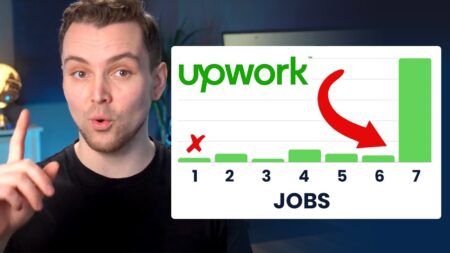Note: This article contains legal advice. We recommend you consult a lawyer before making legal decisions in your business.
Net 30 is one of the most common invoicing payment terms used by small, medium, and large businesses.
While it is a standard payment practice, it isn’t the same for all size businesses, and this is especially true for freelancers and solopreneurs.
Today I’ll explain what net 30 is, why many use it, and why it’s bad for you to do the same. Lastly, we’ll go over the steps you can take to protect yourself against the worst parts of net 30 while still enjoying its benefits.
👋 Psst...Have you seen the all-new Feedcoyote yet? They've got a new look, more freelance opportunities, and the best collaboration tool for freelancers! Join over 100,000 fellow freelancers who network, find clients, and grow their business with Feedcoyote. Join for Free »
What is net 30?
Net 30 is a payment term used as a standard on most types of freelancer invoices. It refers to the amount of time—30 days—that the client has to submit payment for the invoice.
While net 30 is standard, there are also other variations, such as net 10, net 60, net 90, etc. It all depends on the business.
In some countries, like the UK, clients are legally obliged to pay suppliers within 30 days unless the parties have agreed to other terms.
In technical terms, net 30 is a type of short-term credit that you, the supplier or seller, extends to your client. This is because you have already delivered the goods or services, and you are giving your client extra time to pay.
In retail and restaurants, for example, there is no short-term credit: when you buy a pair of shoes, you have to pay for it immediately.
Therefore, seeing as you are giving your client 30 days to submit payment for something already provided, you are extending credit to that client.
Why use net 30?
Net 30—as short-term credit extension—acts as an incentive for the client to use your services or purchase your goods in the first place.
Naturally, people are more willing to buy things if the payment is delayed. This may be one of the reasons that credit cards are used by 20% of Americans for almost everything.
In addition to that, the other incentive is that net 30 is an interest-free credit extension, whereas credit cards and other financing usually contain charges.
For larger businesses, net 30 (and longer payment terms) allows them to keep their cash for longer, which is great for their accounting.
This allows them to delay cash outflows, thereby improving their cash flow in general. With better cash flow, they are in better positions to meet their other financial obligations.
Why net 30 is bad for your freelance business
While that is all great for larger businesses, the reality is that not all businesses are the same. There are a few important reasons that net 30 is not as effective for freelancers.
In fact, it can be quite detrimental.
Not enough clients
Primarily, medium- and larger-sized businesses have multiple revenue streams. They have many clients on rotating payment cycles, meaning they have enough cash flowing in to meet their financial obligations on a regular basis.

Freelancers often don’t have that luxury. Many have one or very few clients that make up their main revenue streams.
If those clients don’t pay (or they don’t pay on time), these businesses don’t have any other revenue options.
Confusion about the timing
Secondly, different clients have different opinions on when the 30 in net 30 actually begins. Some believe that it begins from the date the invoice is issued—which is right.
Others might think that it is when the invoice is actually received. You may believe that it begins when the goods or services were delivered.
However, there is an even worse option: the 30 days begins when your client’s gets payment from his or her client. This means that you won’t get paid until your client’s invoice is paid, which may be an extra 30 days.

That’s 60 days for you to get your money, which for most freelancers is a long time to wait.
If this is your main client, you will have no choice but to continually extend credit and wait for payment. Either that or you cut your losses or go to small claims court—neither of which is a great option.
How to protect yourself
Net 30 doesn’t have to be all bad. There’s a way to use the good parts of it (incentive for the client to purchase) without exposing yourself to the many disadvantages.
Agree
First of all, you should agree with your client about exactly when the 30 days begins.
Having this as an agreement with your client—or even as a general payment policy for all clients—will ensure that you are on the same page. It will act as a reference document that you can look at when there are problems or challenges.
Use net 15

One of the surest ways to protect yourself against past-due invoices is simply to use shortened terms. Instead of net 30, you can use net 21 or net 15.
While this means you should get your money faster, there’s also the tradeoff that you are giving less room for your clients to pay.
Include late fees
It is highly recommended that you include charges for late payment of your invoice. While the net days are interest-free, it shouldn’t mean that everything is interest-free.
You should apply a percentage fee for late payments on a weekly or monthly basis. That means that for every week that the payment is overdue, 5% of the invoice amount is added on top of the original invoice.
This is a strong incentive for your clients to pay faster.
Don’t offer net 30 to new clients
Lastly, one important thing to do is to hold off on your net 30 offer until you can trust your clients. Once the client has provided you regular, on-time payments for your goods or services, then you can offer net 30 payment terms.
For example, if you have a new client, you can use net 15 (or even net 10) payment terms. Inform your client that after 3 successful and timely invoice payments, you’ll extend net 30.
That will be as a reward for your client, and it will show you that your client is a dependable payer.
These four steps will help protect you against the standard net 30 payment terms.
With a better agreement between you and your client, you can have much better relationships and cash flow. And both of these will be crucial to helping you grow your freelance career.
Do you use net days? Let me know in the comments.
Keep the conversation going...
Over 10,000 of us are having daily conversations over in our free Facebook group and we'd love to see you there. Join us!




Great post. Net 30’s can be a horrible trap for new freelancer businesses, especially if you’re not informed on standard payment practices.
We wrote a similar post recently, would love you to check it out!
One other strategy would be the use of an “inception fee”, basically a percentage of the total agreed upon fee (20% is fair) that you bill immediately upon the client’s acceptance of your proposal/estimate/etc., and that MUST be paid within 15 days (or you could request immediate payment, if you’d like). This give you more immediate income, while giving the client the flexibility of the net 3o term for all other invoices for that project. Also, do not hesitate to ask your clients on Day 31 for the status on the processing /payment of your invoice. And repeat asking every few days if necessary. If you do feel it’s necessary to institute a “late fee”, make sure that was clearly stated upfront within your scope of work or estimate. No one, especially clients, likes to be surprised by something like that. If forewarned, they will pony up if late. But if not, they will feel as if you are taking advantage of them (even though you are not). Treat them fairly so that they will do so in turn.
Hi Stephen, great points.
I’m in complete agreement with your upfront “inception fee.” You could even try to up it to 50%.
And I like the idea of contacting them on day 31. I have often emailed my clients on day 30 to let them know that the invoice is “now due.” If they don’t pay within a week, I will call them. There’s something about a live call that really works.
And the late fee definitely has to be agreed upon by both parties before work even starts. One business owner set it at 16% to make sure that his clients noticed it–not for the money, but for the incentive.
I completely agree with you on larger companies cash flow. They do have the luxury of diversified revenue streams and it gives them an edge. I just turned down a net 45 a few days ago! The payment terms I just couldn’t justify. I love the article, great read!
Thanks Micah. I agree–net 45 is just stupendous.
If possible, I always advocate for a net 15. Unless the client is a bigger corporation with stringent rules, there really is no reason for clients to take any longer for payment.
Is it actually legal to charge 5% of the invoice amount on top of the original invoice for late payments? Besides, how do you get clients to pay late fees? You send them another invoice?
This is a tricky question. As far as legality, it is. There are different statutes based on the state you’re in, but they usually cover rental agreements and the like. The late charge only has to be reasonable (and the standard fee is usually 1.5%–some business owners even charge 15%) and agreed to by both parties; i.e., you have to have it specifically stated in your agreement.
As far as getting them to pay–that is the age-old freelancer question. If they didn’t pay the original invoice, why would they pay the adjusted invoice? It can get drastic. If it is a regular client, you can stop work on any current projects until the payment is fulfilled. There are also invoice collection agencies (here’s one specifically for freelancers: http://www.freelancecollection.com/) that will work to get your invoices paid for a hefty percentage (the one above charges 20% to 50%).
Good article. Thanks for walking through the net 30 terms. In my business , I try for net 15 when I can. Bigger corps have standard net 30 day payment schedule. On smaller projects there is more flexibility on terms. New “discount’ terms with $$ before a certain date has worked well. As I begin new relationships I try to iron out terms before begins. Thx. Love Milo!!
Happy you enjoyed the article.
I agree. I think the best option is giving out discounts for early payment.
Best advise is, like you said, to iron all this out and establish it before you begin your business relationships.
Great advice. I agree.
Thanks Vickie, glad you enjoyed it!